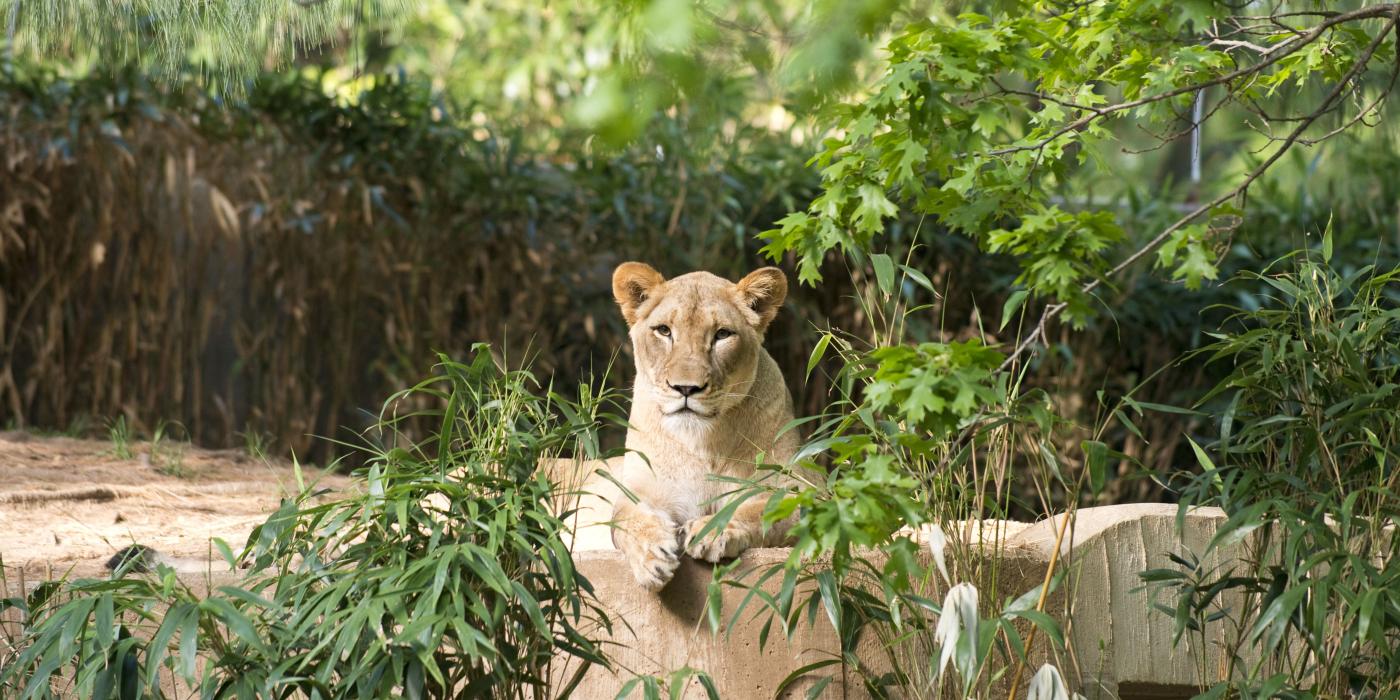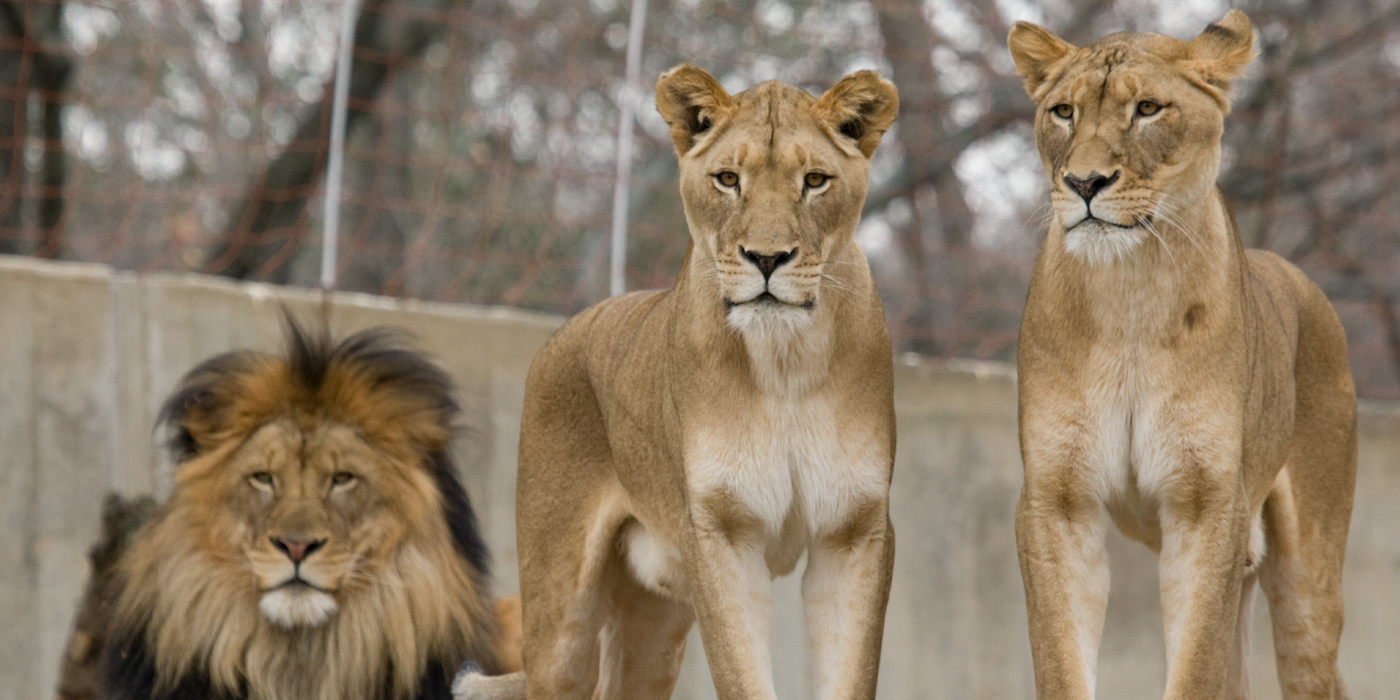Keeping Up with the Great Cats: Lion Pride Edition

Fall is upon us, which means that it’s a great time to visit the Great Cats exhibit to see our African lions in action! When the temperature is between 45 and 65 degrees Fahrenheit, the cats are at their most frisky.
Many visitors who have been coming to the Zoo for years are curious to know whether we are planning to reestablish our social group and add our adult male Luke (who just turned 14 years old) into the mix with our adult females Naba (15 years old), Shera (14 years old), and his daughter, Amahle (5 years old). Although we did several rounds of introductions between Luke and the girls, it was clear that being in the same enclosure was not enhancing their quality of life. In fact, we were a bit taken aback by what little interest they showed in one another!
In years prior, Naba would get so excited whenever we put her and Luke together. Now, though, she just doesn’t respond to him in the same way whenever they are face-to-face. However, what is fascinating is that she will respond to Shaka and Jumbe, our five-year-old males, the way she used to respond to Luke. It makes sense when you think about it — the prime for a male lion is between 5 and 10 years of age. We have not ruled out the possibility of doing reintroductions again down the road. But, for now, we’re taking our cue from them, and it’s clear from their behavior that they are not interested in mixing and mingling.
Those who have been following our lions may remember that Luke is currently undergoing deep-tissue laser therapy, electroacupuncture and dry-needle acupuncture treatments for a lesion on his spine, which was causing a limp in his right forelimb. I am happy to report that since we began these treatments in spring 2018 we have seen significant improvement in Luke’s gait!
As Luke’s primary keeper, I work closely with the Zoo’s veterinary team to administer these treatments. Thanks to our positive reinforcement training program, we do not need to put Luke under anesthesia for the deep-tissue laser therapy portion. About twice a week, he will calmly lay next to the mesh of his enclosure as I massage his shoulder with the probe. To reinforce his good participation, I reward him with meatballs. Now that Luke and I have established a routine, I’m looking forward to teaching these techniques to my fellow keepers so they can assist with this treatment. It’s a big undertaking — but an exciting one!
Although Naba and Shera are moving into their senior years, they are still in pretty good shape. Naba moves more slowly and carefully at times, but we have not seen anything that has concerned us. They seem to be healthy and doing quite well for their ages!
Amahle’s personality is exactly like that of her mom, Shera, when she was 5 years old. She was very quiet as a cub and, along with her brother Jumbe, was often the last to hit the big milestones, such as tasting meat or participate in husbandry training. But, ever since her two half-sisters received a breeding recommendation from the Species Survival Plan and moved to another zoo, Amahle’s personality has changed. In her prime, we can see her rising to the role of alpha female, even though mom and Aunt Naba are still very much in charge.
Of all the lions, Amahle is the most playful. True to her ‘alpha’ personality, she makes it a point to be the first to play with the toys we offer for enrichment. The items we offer our great cats are very similar to the toys you would buy for your domestic cat — just on a very large, heavy-duty scale!
Usually Amahle and Shera hog the special treats and toys in the yard, and Naba waits patiently until they give the item up. I’m not sure I’m very good at convincing our visitors that Naba could take these things for herself if she wanted to. One day, I happened to be saying just that to a visitor a few seconds before Naba demonstrated just how alpha she was! Amahle didn’t even put up a fight. Naba has the sweetest personality, but I love the moments when she reminds the other lions that she’s still the queen bee around here.
Amahle is very attached to her toys, so much so that trying to get her weekly weights is often a challenge. We weigh the lions every Thursday morning. For whatever reason, that is always the time she wants to play the most. One week, I had such a tough time getting her to leave her favorite boomer ball that, eventually, she just took it with her on the scale!
The aforementioned boomer ball is a favorite of all our cats, not just Amahle. I think it is because the 12-inch diameter makes it easy for them to pick up and carry around in their mouths. Out of all the toys, it also rolls the fastest—so it’s fun for them to chase!
All of our toys are selected to encourage the cats to use their natural behaviors. Once such toy is an unevenly weighted ball. Due to the odd weight distribution, it rolls in a funny pattern, mimicking prey zigzagging away.
As one can imagine, these toys — though well-loved — can quickly become weathered from our lions’ teeth and claw marks. One way fans of our lions can help keepers purchase new toys is by making a donation to the Enrichment Trunk.If you are trying to tell Amahle, Naba and Shera apart, take a close look at their noses. As lions get older, black dots begin to appear. Amahle’s nose is still all pink, whereas Naba and Shera’s noses are almost all black. There are a couple of ways to tell Naba and Shera apart. Naba has a shorter, stockier and broader body, whereas Shera is more tall and slender. Naba also has small mark in the shape of an asterisk on her nose from where an old growth was surgically removed. You can also look at their ears; Naba’s appear to be flat on the top, whereas Shera’s are rounded.
The boys, on the other hand, have very distinguishing features, so it can be easier to tell them apart from far away. For starters, Jumbe has a bit more red in his mane and his body, giving him a darker appearance. Shaka, meanwhile, has more blonde in his mane and fur that is lighter in color overall. If you have a camera with a good zoom lens, you may even be able to spot some scars on Shaka’s nose.
Between the two brothers, Shaka is much more food-motivated. He is always excited about food, and it is rare to see him express that he’s full! In order to do husbandry training sessions with Shaka, I need to feed him quite a bit of his diet before we even begin and let his tummy settle so that he is not feeling hungry when we train. Jumbe tends to be the more laid-back of the two. He’s not as food-motivated as Shaka. In fact, when he is done eating, he will just leave his food — something Shaka would never do!
Jumbe also seems the most interested in spending time with Naba, Shera and Amahle. Although they never share an enclosure, they have visual access to one another through “howdy” doors. Frequently, Jumbe will hang out and keep an eye on them. Jumbe can be quite anxious anytime he is separated from his brother. For that reason, we decided to keep them here at the Zoo for the time being. It is possible that they could receive a recommendation to go to another Zoo for breeding, but we have made a request that, if so, the brothers stay together for Jumbe’s well being.
If you are planning a trip to the Smithsonian’s National Zoo this fall, I recommend stopping by between 11 a.m. and 1 p.m., as that is when the lions are most likely to be up and moving about their yards. We love introducing our cats to visitors, and the best way to learn more about them is through our daily keeper talks, which take place daily at 11:30 a.m. and 1:30 p.m. I hope to see you there!
This story appears in the November 2019 issue of National Zoo News.
Related Species:


